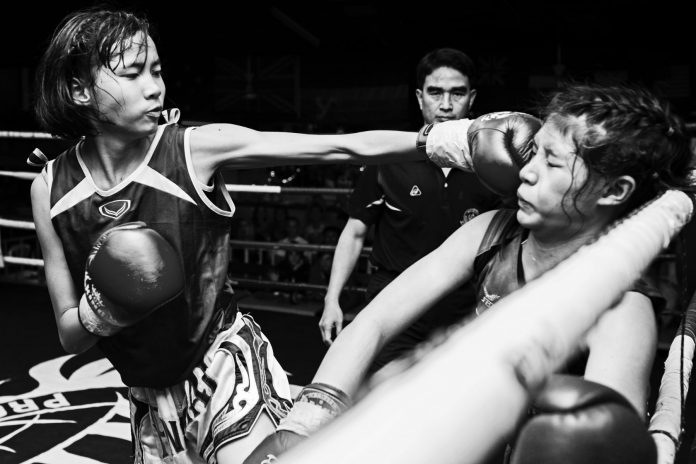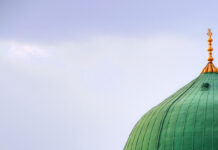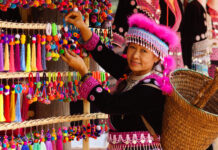
Pack a punch with the traditional martial art form of Muay Thai
Text by Jim Welch
Photo by Lord K2
Muay Thaai, otherwise known as ‘The Art of Eight Limbs’, is Thailand’s form of boxing that makes lethal use of eight contact points of the body, including the hands, shins, forearms, knees and feet. It has become one of the primary reasons for martial arts devotees to visit the country – from the serious practitioner training for the next fight, to the casual tourist looking for a little physical conditioning between days on the beach. The popularity of the sport has grown so rapidly that local economies have been founded – and are thriving on – Muay Thai’s new in vogue status, making it a booming, year-round highlight of Thai tourism. This brand has been successfully packaged and exported for worldwide consumption.
The exact origins of Muay Thai have been debated by the numerous scholars who have researched this martial art form. By some accounts, aspects of this fighting form are believed to have come from China, stemming from the outward flow of immigrants to the southeastern parts of Asia. Some believe that Muay Thai’s infancy originated from the Khmer Empire (the predecessor to modern Cambodia), from a martial art called Pradal Serey. What is certain is that the sport of Muay Thai was spawned from the many early Thai combat fighting styles located throughout the region. Muay Chaiya, Mae Mai Muay Thai, Muay Lopburi and Muay Korat were the several styles that, with time, merged to form the practice of Muay Boran, which translates to ‘ancient boxing.’ Further consolidation of fighting styles with the eventual veer away from its application as a combative practice towards a sport led to what we know today as Muay Thai.

The Sukhothai Era, 1180–1377
Traditional Thai historians have noted that it was during the early- to mid-12th century that the Sukhothai Kingdom was founded as the beginning of the Thai nation. It was here, in what is today central Thailand, that battles raged against the Khmer Empire. Large swaths of fighting forces were dispatched to first, win succession, and then defend the young capital city. With the birthing of a new national identity taking place, it is thought that the formative style of early Muay Thai hand-to-hand combat was created here. During this period, it was expected that everyone – from the common people to royalty – would practice the disciplines of Muay Thai.
The Ayutthaya Era, 1400s – 1590
Periods of conquest between the neighbouring kingdoms of Sukhothai and Kamphaeng Phet and Phitsanulok continued the ongoing refinement of the Muay Thai martial art. As attempts at dynastic unification continued, the fighting style of Muay Thai evolved in both technique and as a cultural dividing force during ongoing conflicts between the Angkor Empire and later, Burma.
In the latter years of the 16th century, numerous wars continued to be fought against Burma, but it was under the reign of one of Thailand’s most revered monarchs, King Naresuan, that there was a turning point for Muay Thai. Owing to his passion for the Muay Thai fighting style, King Naresuan was instrumental in creating the first great upsurge of interest in the art as a local sport.
It was during this time that new sporting fighting techniques evolved and led to the beginning of Muay Thai competition. Early professional fights were by no means a friendly affair, as no time limits were given, and so bouts of fighting continued until either competitor gave up, or was knocked out. The increasing public appreciation of Muay Thai as a local sport meant that it slowly moved away from its early raw combatant roots towards a more recreational practice.
King Prachao Sua the ‘Tiger King’, 1697 – 1709
Another historical figure who was instrumental in keeping Muay Thai culturally intact was King Prachao Sua, the king who loved competing. He was known for entering competitions disguised as a commoner in order to be able to fight unhindered by his revered royal status. Because no one recognised him as the king, he was able to participate in tournaments against highly skilled and notable fighters.
But while the identity of Muay Thai was flourishing as a sport domestically, conflicts with neighbouring Burma had not yet played out. In 1767, the invading armies of Burma attacked the Ayutthaya Kingdom of Siam. During this period of the conflict, many Thai fighters were captured and taken to Burma. This is where the legend Nai Khanom Tom was born.
Known for his mastery of fighting skills, Nai Khanom Tom was chosen by King Mangra of Burma to participate in a seven-day festival. Put up against a Burmese champion, it was said that Nai Khanom Tom overwhelmed his opponent, ending the match with a swift defeat by knockout. Following this, King Mangra offered Nai Khanom Tom his freedom – if he could successfully defeat nine more Burmese fighters in succession. Legend has it that at the end of the tenth fight, Nai Khanom Tom was released and provided with safe passage back to Siam, along with two Burmese wives. Because of Nai Khanom Tom’s legendary heroics, Thailand celebrates Boxer’s Day – or National Muay Boran Day – on March 17.
The Golden Age of Muay Thai
King Rama V was another figure in Thai royal lineage who promoted the sport. From the late 1880s onwards, his involvement in tournaments and important international events helped elevate the identity and status of Muay Thai, nationally and abroad. Like his predecessors, it also provided a means for him to find personal guards and royal officers. In 1887, the Department of Education was created, which included Muay Thai as part of the military cadet teachers school curriculum.

Modern Muay Thai
The turn of the 19th century witnessed changes that highlighted Thailand’s collaboration with – and acceptance of – outside influence. Its most dramatic shift in terms of the social political landscape occurred prior to and in the wake of the fall of King Rama VII. Sweeping changes took place within Thailand that resulted in many of the old ways being discarded. The direct impact of these times on the sport could be seen in the introduction of British boxing into the Muay Thai curriculum at Suan Kulap College. It was around this time that the sport was codified; rules and regulations were introduced. This led to the incorporation of the first international-style three rope ring with red and blue padded corners. The fighters were relieved of the rope binding of the arms and hands as padded gloves took their place.
After the world wars, large stadiums were built and remodelling continued. Weight classes were introduced, and five rounds with a time limit were included. The makeover of refining the sport’s conduct helped promote Muay Thai’s appeal to a foreign audience. Muay Thai had entered a new period, increasingly influenced by the West with more stringent standards of professionalism.
Today, Muay Thai’s allure continues to grow, and large gatherings in Bangkok’s Rajdamnern and Lumpinee stadiums are an anticipated weekly event. The broadcasting of these live events began over two decades ago, and continue to be shown to fans throughout Thailand today.
On a global scale, Muay Thai has become one of the fastest-growing martial art practices. It has been firmly established as one of the integral pillars in today’s multi-million dollar mixed martial arts industry. As it gains increasing acknowledgement around the world, Muay Thai’s possible inclusion in the Olympic Games seems likely.
Look closer
I recently decided to take a closer look at this fast-rising industry to get a better sense of what kind of people are attracted to the sport, and to find out if this relatively new sporting craze is here to stay. I made my first acquaintance with Muay Thai in the province of Phang Nga, situated on Thailand’s southern Andaman coast. It was here that I found a modest but attractive training camp nestled within a quiet rural community.
Underneath a high roofline of steel girders and metal roofing to guard against the midday tropical sun, a mix of sweat-drenched apprentices were enthusiastically learning their trade. A chaotic blur of flying limbs accompanied by demanding commands from seasoned instructors occupied the four separate boxing rings. I quickly retreated behind the relative safety of my viewfinder, where I could observe exhausted tourists and motivated expats dressed in flamboyant shorts obediently executing pad strikes to the synchronised bellowing of their Thai trainers.
Standing alone as he tested his hand wraps, Darren, an expat from Canada, was getting ready for a training session in preparation for his third professional fight. I asked him why he had decided to choose this particular camp, and what he looks for when considering a place to train.
“I prefer training somewhat off the beaten path, as I find that too many people sometimes amounts to less quality or not enough coaching time,” he shared. Pressing him further, I asked if he could elaborate on the different qualities of Thai boxing gyms.
“Usually, if you are a dedicated fighter, you’ll be given the attention you need. But I have witnessed occasions where the trainers have not taken their craft too seriously, or there are just too few trainers for the number of students in a class. I’m worried that the success of Muay Thai is changing the spirit of the sport. I guess when you go global, a bit of the soul gets kicked out of it.” Darren adjusted his hand wraps and climbed back into the ring.
Later, he went on to mention that while the training itself is fundamentally the same and consists of routine small-pad combined with heavy-bag workout, each gym can vary the training process. The mushrooming variety of gyms in Thailand can be as diverse as their clientele, from opulent resort-styles for the wealthy, to the gritty, street-roped gyms for those with more modest incomes. He explained that geographic location tends to be a big factor; there are innumerable options throughout Thailand, from cities to mountains and camps near the sea. “These days, the bigger, big name camps have actually diversified into a broad spectrum of other forms of health and fitness opportunities such as yoga, cross-fit, and Brazilian jujitsu. I chose this camp because it’s focused exclusively on Muay Thai,” he explained.
Situated a few hours south, on the island of Phuket, is the high-octane nightlife of Patong Beach. For a few nights a week, a boxing stadium in the heart of Patong fills with both tourists and Thai people. I attended fight night and sat ringside next to a local Thai trainer who was there to support his club’s young fighters.

“Many people have come to watch the fighting tonight,” he said, flashing a wide smile of pride as the first boys entered the ring to perform the pre-fight ritual. The signature high-pitched whine of the Thai boxing music called sarama echoed through the stadium. The Muay Thai dance, known as wai khru ram muay, is a pre-fight tribute performed in honour of the local club and its trainer. It is a tradition dating back to a 16th-century fighting style that was born from the battles fought between Burma and Siam. The Siamese warriors soon developed one of the fiercest reputations throughout Southeast Asia in this extremely effective ‘eight limb’ offensive-based combat discipline.
The first round commenced with a face-off between two boys of eight and ten years old. Both boys had engaged in previous fights and were beginning what they hoped would be promising careers. “This depends on whether they continue with a strong heart and with few injuries,” their trainer said.
The fighting was a violent reality check: I witnessed several bloody knockouts from connecting fists and head-kicks that brought home the risks involved in full-contact Muay Thai. As if reading my thoughts, the trainer said, “There’s a big difference between fight night and padded training in the gym. And I make sure that each one of my students watches this before I allow them to step into the ring.”
The night’s fights ended with two highly skilled opponents trading powerful blows. All around the ring, the crowd reached a deafening crescendo as the Thai supporters cheered for the victory of their local fighter. This was Thai culture in hot-blooded action, reflecting the strength, beauty and grit of the ancient traditions of the Muay Thai legacy.
For more stories and photos, download a digital copy of Asian Geographic Issue 121 here! And subscribe here!










